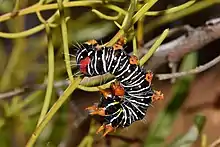Comocrus behri
Comocrus is a monotypic moth genus in the family Noctuidae erected by Karl Jordan in 1896. Its only species, Comocrus behri, the mistletoe moth or mistletoe day moth, was first described by George French Angas in 1847.[1] It is widely distributed in southern Australia from Perth to Melbourne and adjacent to Bass Strait, occurring as far north as Derby, Western Australia, and Clermont and Rockhampton in Queensland. It may be seen during daylight hours hovering around mistletoe species such as Amyema miquelii, Amyema melaleucae and Amyema cambadgei growing on Casuarina and Eucalyptus trees. The adult moths feed on Eucalyptus flower nectar,[2] have a wingspan of some 58 millimetres and are basically black with white bands running through the wings. Individuals ready to mate exhibit 'hill-topping' behaviour, flying to high points in the landscape and there encountering mates.[3]
| Comocrus behri | |
|---|---|
.jpg.webp) | |
 | |
| Scientific classification | |
| Kingdom: | |
| Phylum: | |
| Class: | |
| Order: | |
| Family: | |
| Genus: | Comocrus Jordan in Rothschild & Jordan, 1896 |
| Species: | C. behri |
| Binomial name | |
| Comocrus behri (Angas, 1847) | |
Synonyms
- Agarista casuarinae Scott, 1864
- Agarista flexuosa Walker, 1865
- Agarista contorta Walker, 1865
- Agarista cortortus Jordan, 1896
- Agarista casuarina Jordan, 1912
- Agarista cortutus Nye, 1975[4]
References
- Savela, Markku (15 October 2005). "Comocrus Jordan in Rothschild & Jordan, 1896". Lepidoptera and Some Other Life Forms. Retrieved 19 April 2020.
- Mistletoe Moth | Strathbogie Ranges – Nature View
- Noctuids, Cutworms, Armyworms or Semi-Loopers
- Comocrus behri: Mistletoe Moth | Atlas of Living Australia
External links
- Herbison-Evans, Don & Crossley, Stella (19 August 2020). "Comocrus behri (Angas, 1847) Mistletoe Day Moth". Australian Caterpillars and their Butterflies and Moths. Retrieved 19 November 2020.
- CSIRO Ecosystem Sciences - Australian Moths Online
- Flickr Hive Mind Gallery
- Distribution map